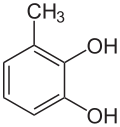3-Methylcatechol
 | |
| Names | |
|---|---|
| IUPAC name
3-Methylbenzene-1,2-diol | |
| Other names
2,3-Dihydroxytoluene 3-Methylpyrocatechol Dihydroxytoluene | |
| Identifiers | |
3D model (JSmol) |
|
| ChEBI | |
| ChemSpider | |
| ECHA InfoCard | 100.006.975 |
PubChem CID |
|
| UNII | |
CompTox Dashboard (EPA) |
|
| |
| |
| Properties | |
| C7H8O2 | |
| Molar mass | 124.139 g·mol−1 |
Except where otherwise noted, data are given for materials in their standard state (at 25 °C [77 °F], 100 kPa). | |
| Infobox references | |
3-Methylcatechol is a chemical compound.
Metabolism
The enzyme 1,2-dihydroxy-6-methylcyclohexa-3,5-dienecarboxylate dehydrogenase uses 1,2-dihydroxy-6-methylcyclohexa-3,5-dienecarboxylate and NAD+ to produce 3-methylcatechol, NADH and CO2.[1]
The isofunctional enzymes of catechol 1,2-dioxygenase from species of Acinetobacter, Pseudomonas, Nocardia, Alcaligenes and Corynebacterium oxidize 3-methylcatechol according to both the intradiol and extradiol cleavage patterns. However, the enzyme preparations from Brevibacterium and Arthrobacter have only the intradiol cleavage activity.[2]
Related compounds
The 3-methylcatechol structural motif is rare in natural products. Known examples include calopin and a δ-lactone derivative, O-acetylcyclocalopin A, which have been isolated from the fungus Caloboletus calopus.[3]
References
- Higson FK, Focht DD (1992). "Degradation of 2-methylbenzoic acid by Pseudomonas cepacia MB2". Appl. Environ. Microbiol. 58 (1): 194–200. PMC 195191. PMID 1371658.
- Extradiol Cleavage of 3-Methylcatechol by Catechol 1,2-Dioxygenase from Various Microorganisms. C. T. Hou, R. Patel and M. O. Lillard, Appl. Environ. Microbiol., March 1977, volume 33, issue 3, pages 725-727 (abstract)
- Hellwig, V.; Dasenbrock, J.; Gräf, C.; Kahner, L.; Schumann, S.; Steglich, W. (2002). "Calopins and cyclocalopins – Bitter principles from Boletus calopus and related mushrooms". European Journal of Organic Chemistry. 2002 (17): 2895–904. doi:10.1002/1099-0690(200209)2002:17<2895::AID-EJOC2895>3.0.CO;2-S.